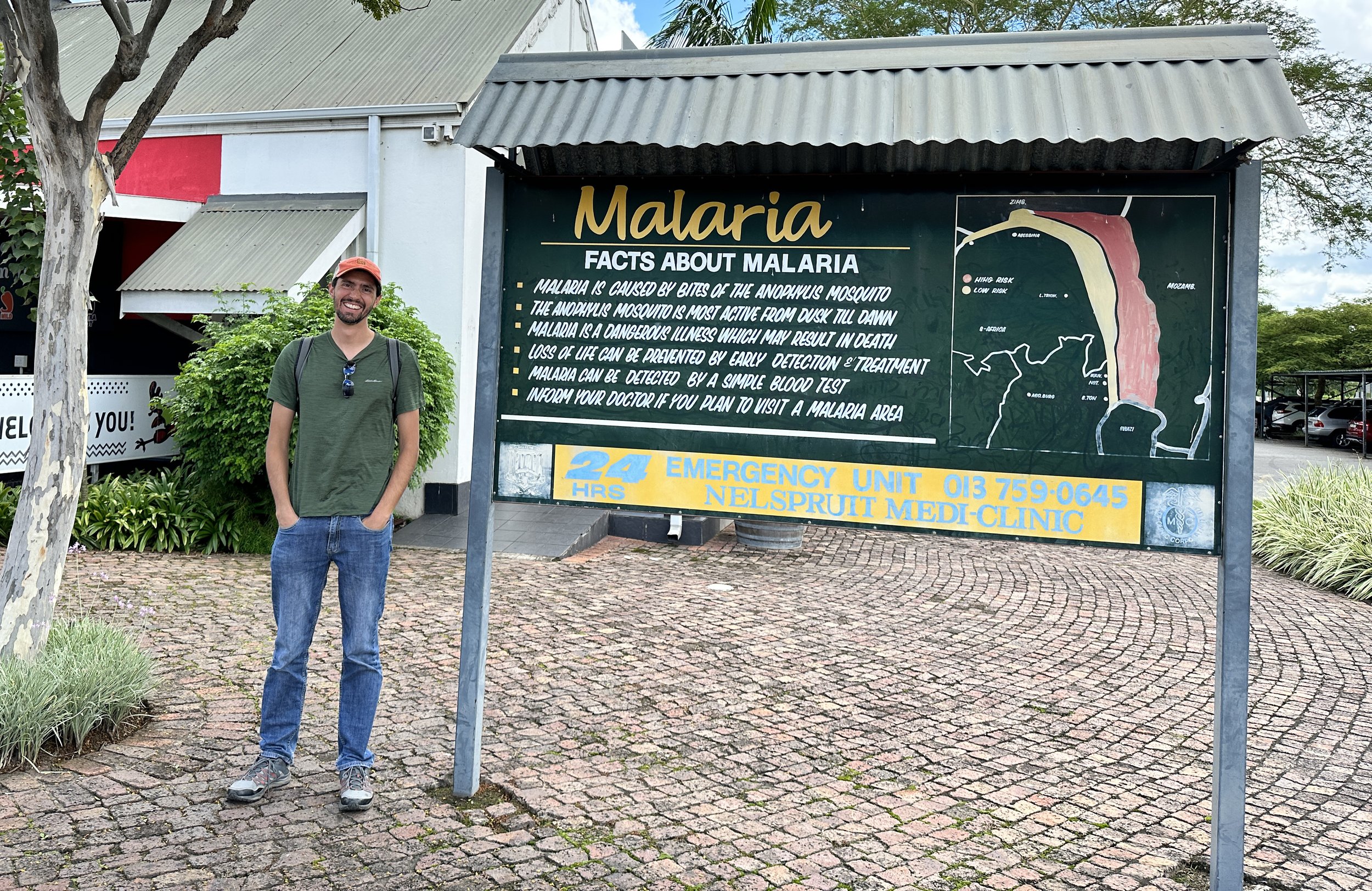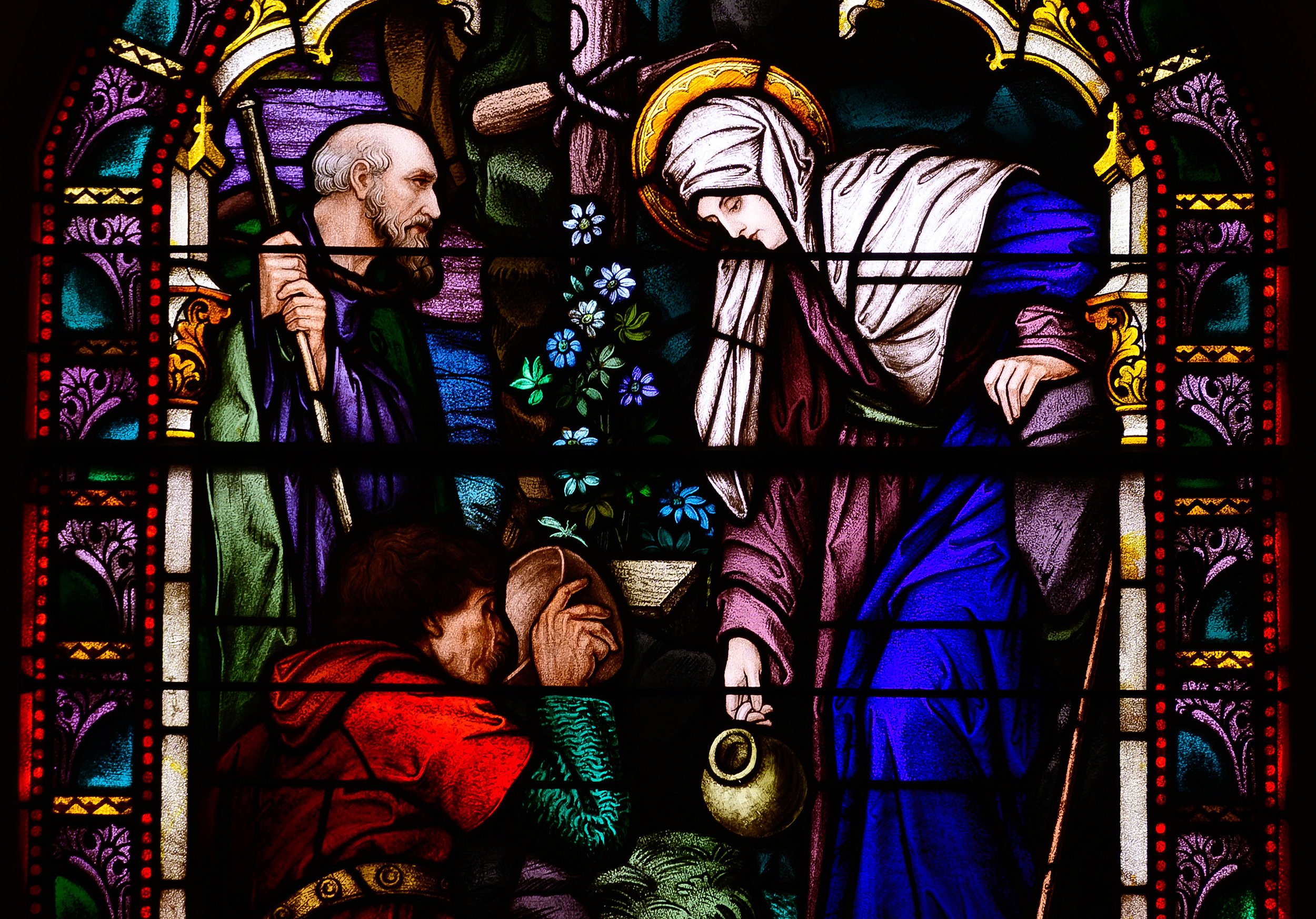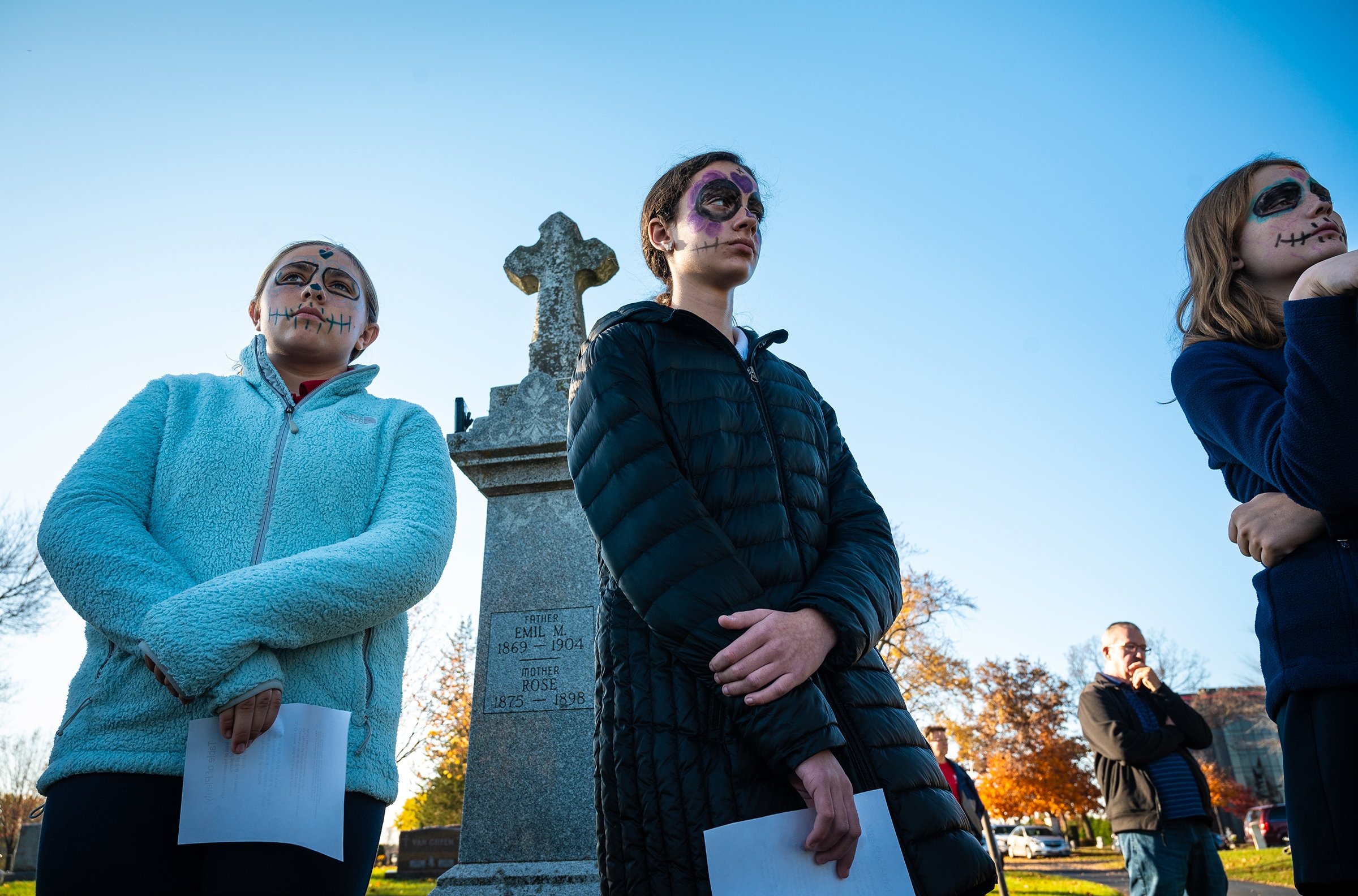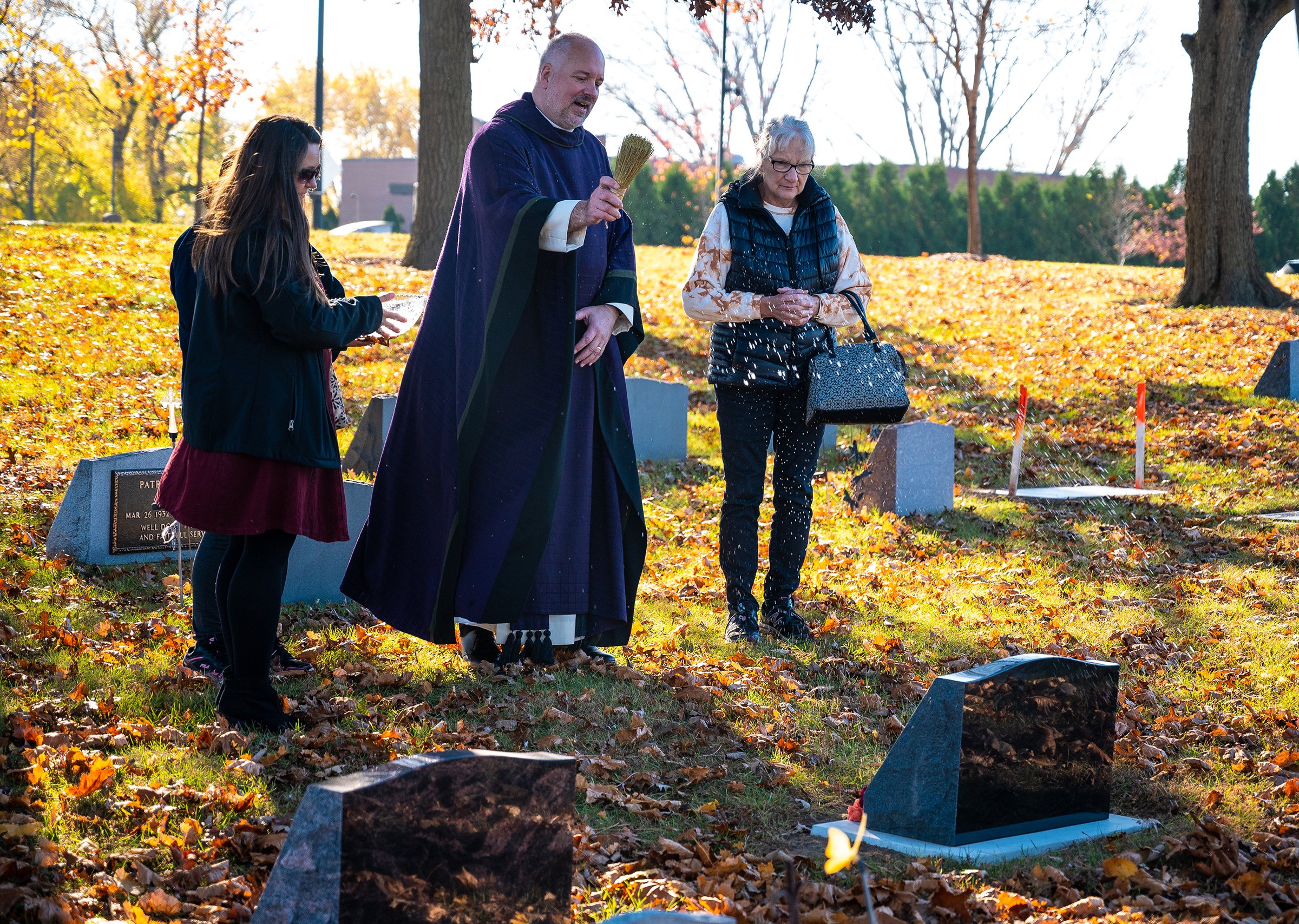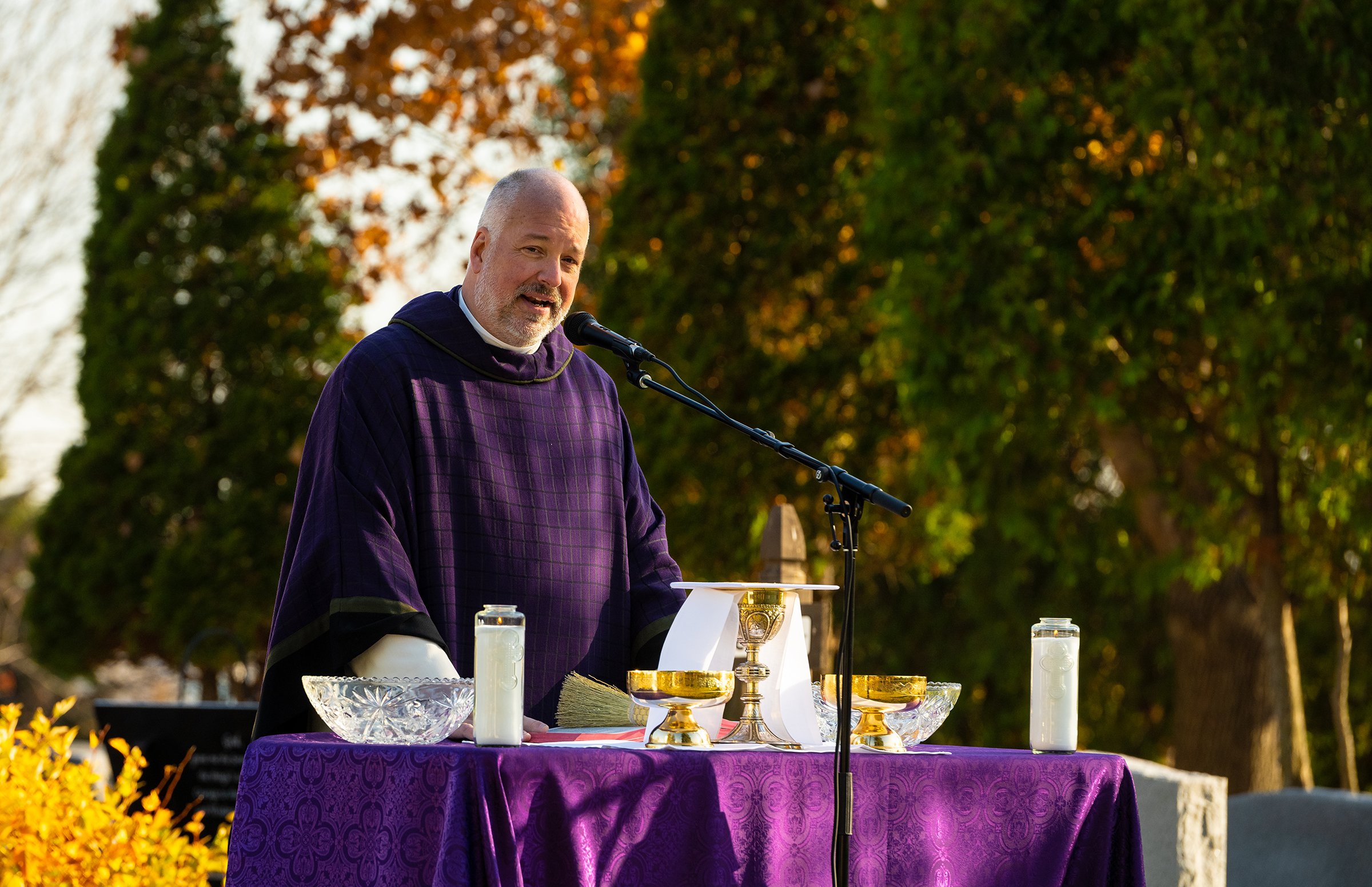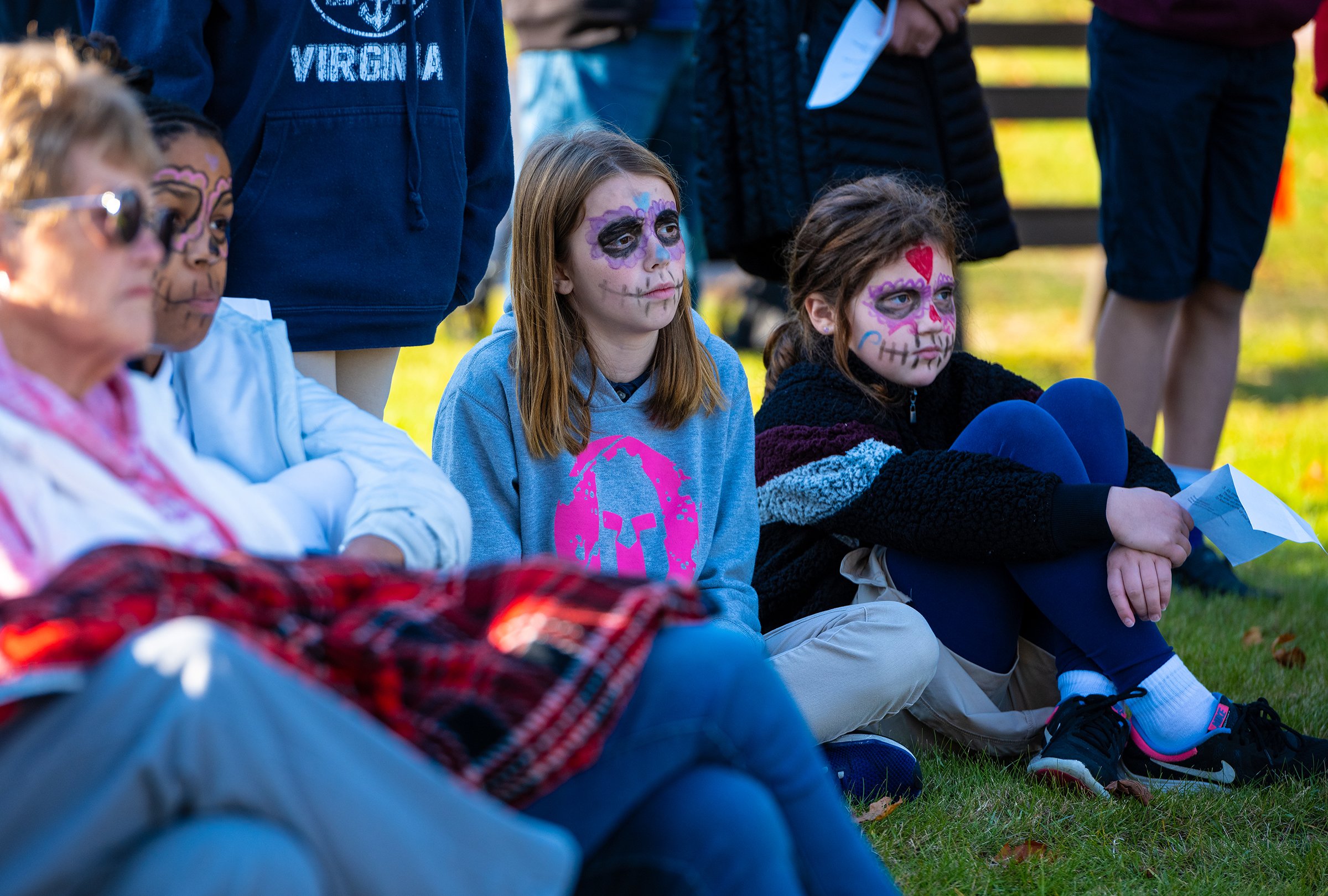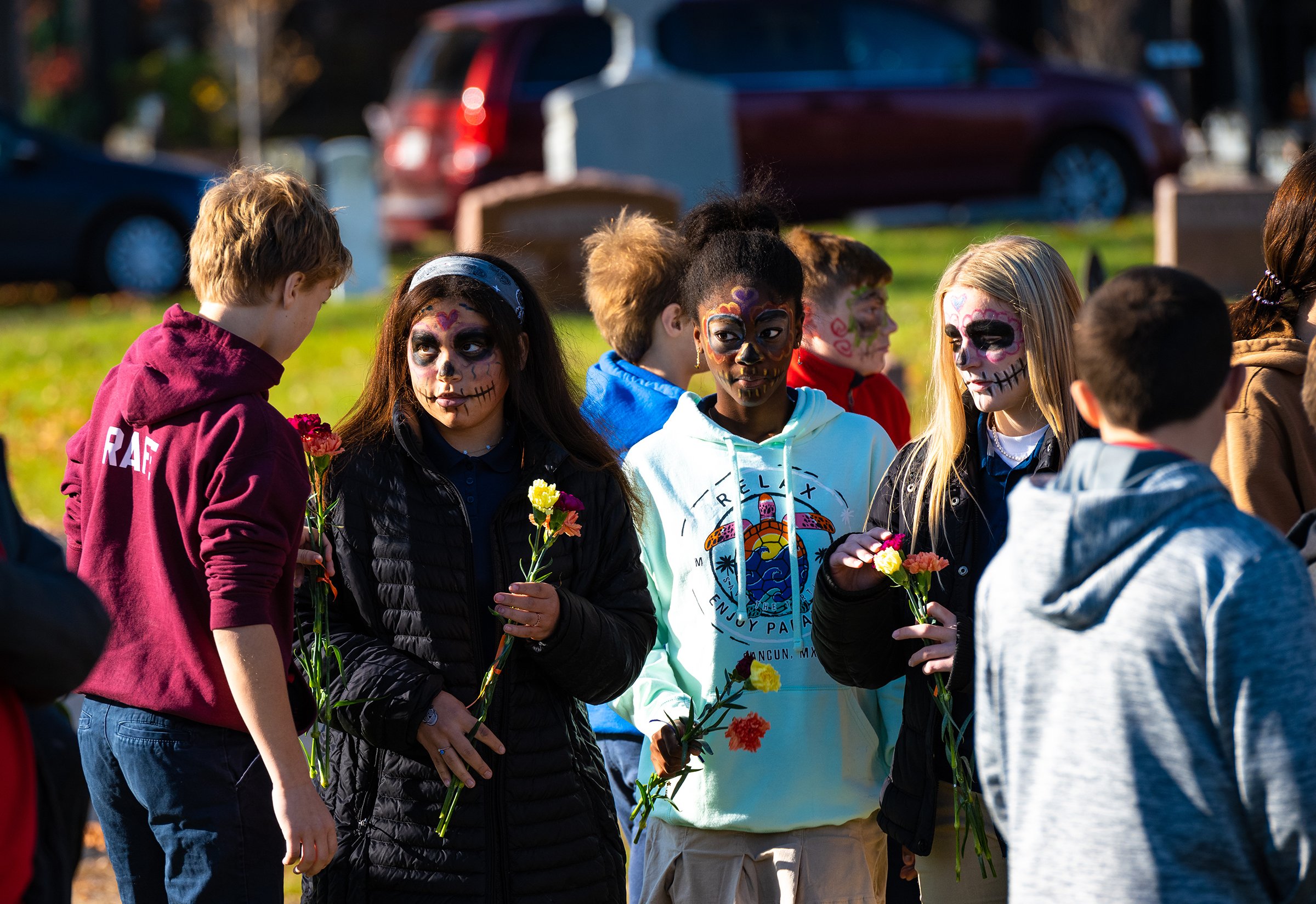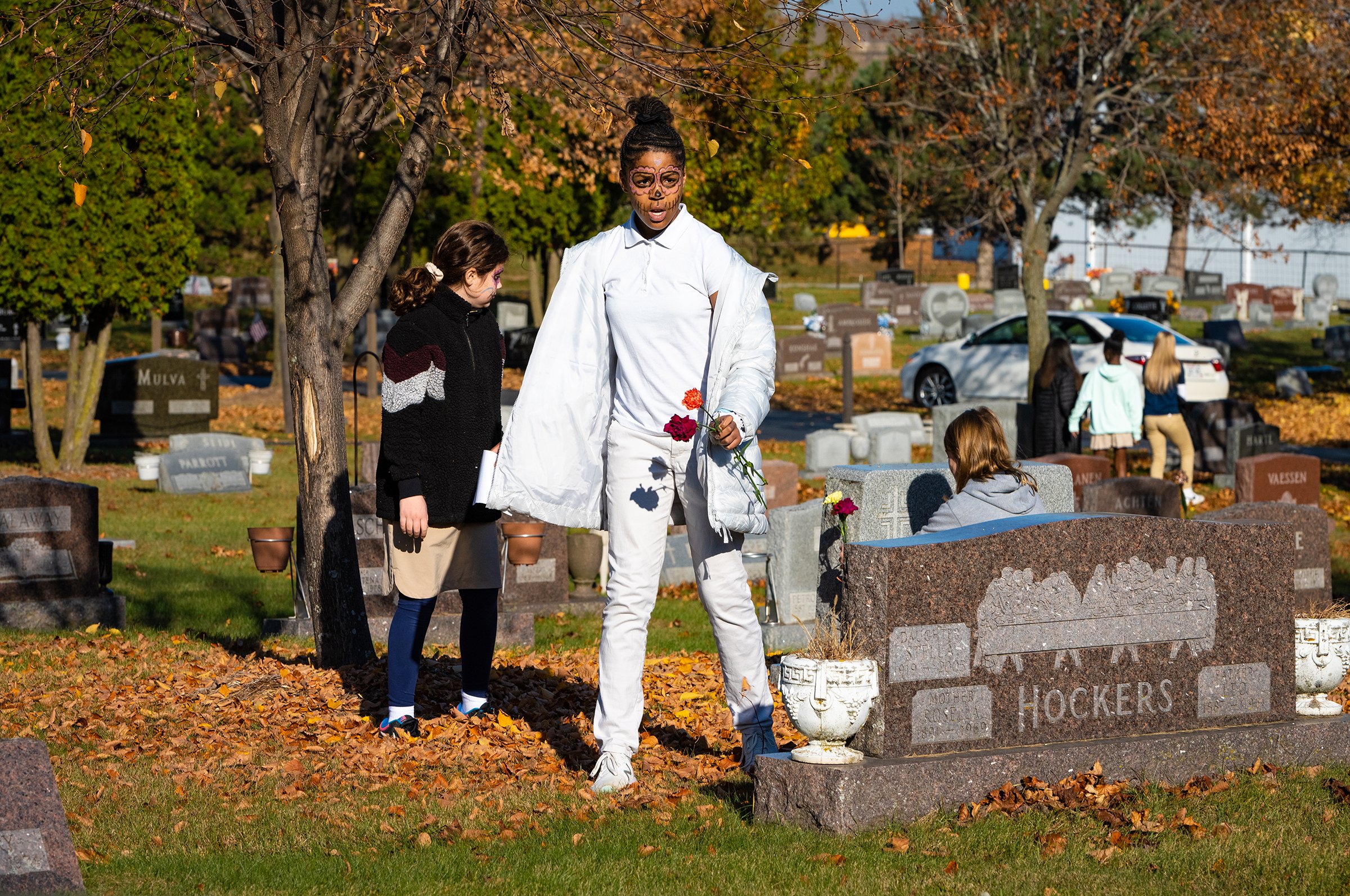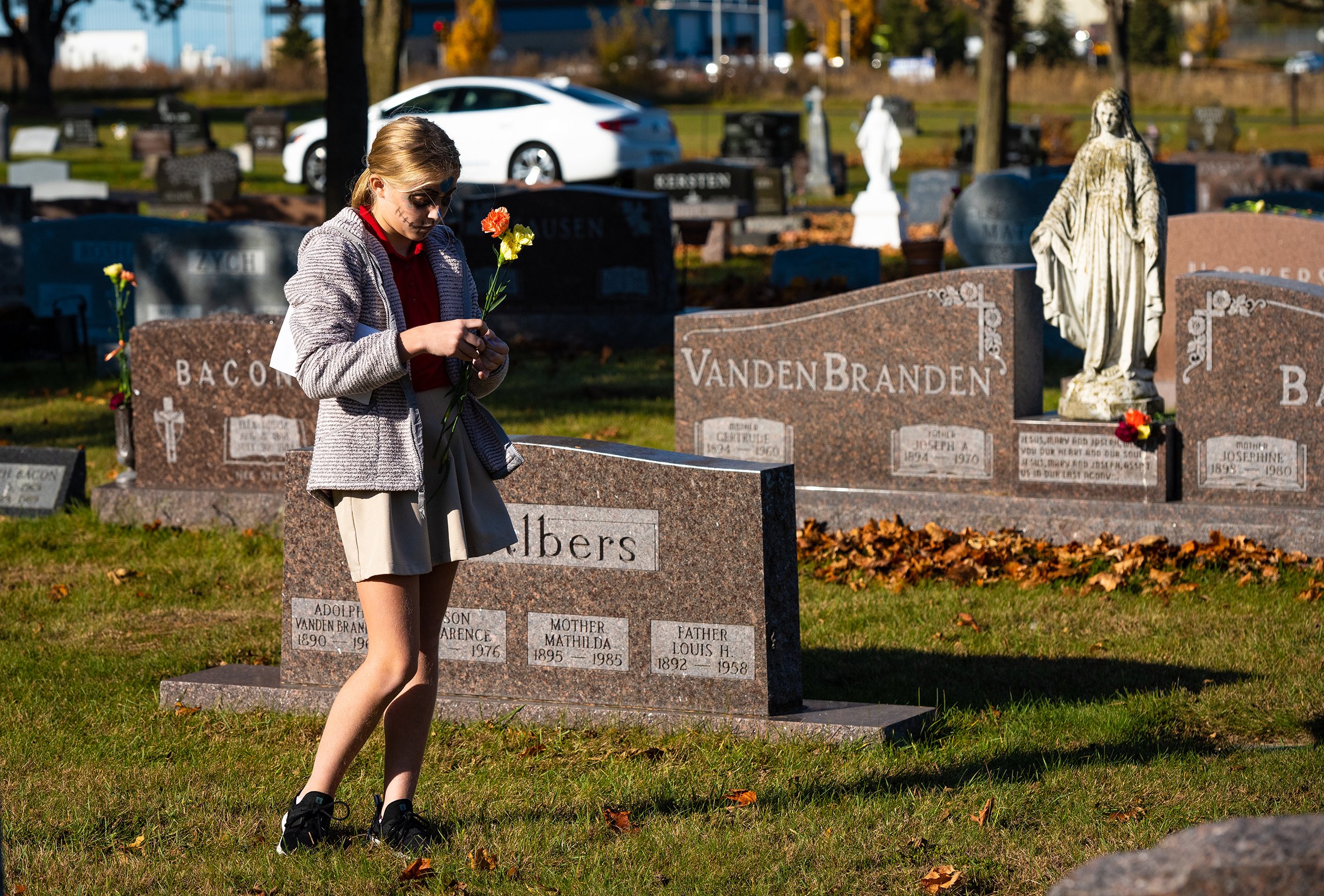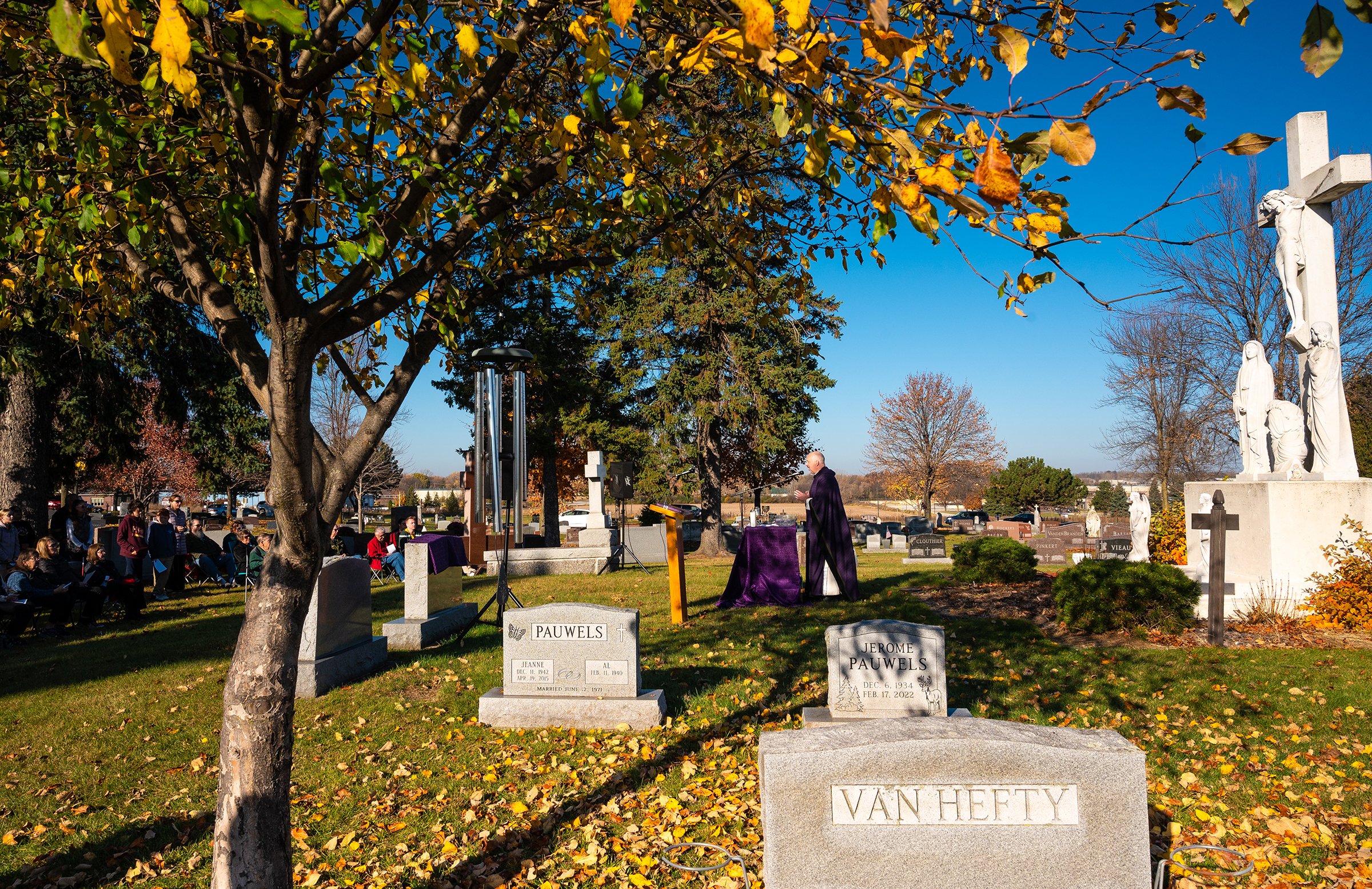African Adventure
A slideshow of group shots from Africa
Group shot outside of Victoria Falls National Park in Zimbabwe.
Below is a slideshow of photos featuring group shots taken during our November African adventure. The trip included stops in Johannesburg, South Africa; Gaborone and Kasane, Botswana; and Victoria Falls, Zimbabwe.
Seeing God in the eyes of children
God’s face revealed in images of beautiful people
Editor’s note: I wrote this column in December 2001, my final editorial before resigning as editor of the Superior Catholic Herald. I'm posting it here because it makes references to photography! A wall in my office at the Chancery in Superior is decorated with pictures. Some are color photos taken in Central America; a few are black and white shots of my wife and kids. The remaining pictures are ones taken while covering events in the diocese.
I love taking pictures. They can communicate a message or record a moment in time in a way words cannot. Most of the pictures on my wall, as well as others pinned to a room divider, are of children: a trio of girls dressed in angel costumes at a Christmas play at Cathedral School in 1987; a youngster smiling as Bishop Raphael Fliss holds his episcopal miter over the boy’s head; Guatemalan children peering from behind a barbed wire fence; and a girl holding a palm branch during the entrance of a Palm Sunday liturgy. I believe that in the eyes of children we see God.
Superior Catholic Herald staff, correspondents, columnists their spouses and diocesan leaders gathered at the home of Bishop Raphael Fliss in 2000. The reception was to celebrate the Year of Jubilee 2000 with communicators.
This week I will begin taking down the pictures from my wall and room divider and packing them in boxes. In a few weeks I will begin a new job at the Milwaukee Catholic Herald, where the opportunity to take pictures, write stories and editorials, and work with a large staff of committed Catholic journalists awaits me.
Serving as editor of the Superior Catholic Herald for the past 14 years has been a joy and blessing. How many people can gain spiritual satisfaction while earning a living? Working in an environment that is conducive to family values and promotes participation in religious activity is a situation very few people experience.
One of the rewards of this job is traveling around the diocese and interviewing some interesting and inspiring people. Women and men who live their faith quietly or who serve other people without fanfare. They are the salt of the earth. The amazing thing is that there are so many like this here in our diocese. I’m thankful to have met some of them.
Speaking of thanks, there is plenty to be offered. Especially to those who showed enough confidence in a 27-year-old Hispanic who never attended Catholic school and, to top it off, grew up in Utah.
People around the diocese know Bishop Fliss as a man of self-effacing humor. He’s also a man of patience and trust. As publisher of the Superior Catholic Herald, Bishop Fliss trusted me to produce the diocesan newspaper each week. I had the free rein, and on those occasions when the limits were tested, he was patient and understanding, never condemning.
After having worked at two other Catholic newspapers and being acquainted with dozens of other diocesan editors, I know the relationship between editor and publisher is the single most important factor in an editor’s tenure. Just as the bishop has thanked me for 14 years of service to the diocese, I publicly thank him for allowing me to practice and improve my journalistic skills here.
Skilled journalists have served this newspaper in the form of correspondents. Working with the likes of Mary Grieco, Paula Graham, Joe Winter, Mary Caton-Rosser, Sallie Bachar and Jeff Peters has made the job of covering news in this 16-county diocese a workable task. The good news is that these incredibly gifted writers will continue to serve the diocesan newspaper.
There are many people in the diocese to whom I owe a debt of gratitude for support and encouragement over the years. Unfortunately, space does not allow for that. To them and to all our faithful readers, I wish you abundant blessings from our loving God, who has shown his/her face to me in the photographs of all the beautiful people captured on film around the diocese.
Make room in your pew
Are you one of the ‘Aisle People’?
An elderly woman sits in a pew at All Saints Catholic Church in Denmark, Wis. (Sam Lucero photo)
Editor’s note: In a recent blog post, the Center for Applied Research in the Apostolate at Georgetown University noted that Sunday Mass attendance in person has risen to 24% since the declared end of the COVID-19 pandemic in May 2023. “Christmas in 2024 was the first time Mass attendance for this holiday reached its 2019 level,” the post stated. This news gives me an opportunity to share the following editorial I wrote in 2016: “Make room in your pew.”A letter to the editor in another diocesan newspaper caught my attention last week. It was on a topic I muse about nearly every weekend at Mass: people in the pews. More specifically, people sitting at the ends of the pews.
Here is what the letter writer says: “The AP (Aisle People) covet the seats at the end of the pew regardless of the emptiness within. … The AP make up approximately 30 percent of attendees and I am not sure they realize the angst they cause in other parishioners.”
Does this resonate with you?
It’s an unwritten rule, it seems, that if you’re early for church you get to claim your seat. Usually that’s at the end of a pew. But what happens when other folks, who sometimes arrive after the processional, arrive? Let our letter writer tell the story:
“Everyone who attends Mass … has no doubt noticed that the late arrivals will ‘probe the line’ looking for a charitable aisle person to allow them to enter the pew. It disgusts me to see how many AP stare straight ahead, ignoring the petitioner’s tacit plea to access the vacancies within.”
The writer’s words may be a bit extreme, but it’s safe to say we’ve all witnessed this occurrence. Aggie Catholic, a popular Catholic blog hosted by the campus ministry team at Texas A & M, even included this subject in its post, “Mass Etiquette: 20 Things to Do and Not Do in Mass.”
“Don’t sit on the edge of the pew if you sit down before others,” the blog post states. “Rather, sit in the middle so others don’t have to climb over you.” It also suggests that men be gentlemen and give up their seats to women, the elderly or disabled.
Some Mass-goers have good reasons to sit near the aisle. They might have a role in the liturgy, such as lector. They might also have a health condition that requires a quick and easy exit from church.
But for the rest of us, can we find ways to be more welcoming? If we are determined to keep that seat by the aisle, at least be courteous to others. Stand or exit your pew and allow them to easily take a seat. Better yet, make it your penance for pew greed by sliding to the middle on occasion.
What can parishes do to make their members more aware of the situation? It begins with hospitality. If the role of all baptized Christians is to make others feel welcome in the house of the Lord, shouldn’t it start by welcoming them into our pews? If not, our pew parochialism may resolve itself as people who feel unwelcome at Mass simply stop attending.
A blurb in the parish bulletin can remind people to make room for others. Ushers can gently ask Aisle People to kindly slide over or allow others to pass. Even the priest-celebrant can offer a few words in his welcoming remarks.
A plea for global health sanity
The impact of the foreign aid freeze.
Dominic, the epidemiologist.
My son Dominic is an epidemiologist in Africa, helping to mitigate malaria in numerous African countries. His graduate degree was in global health and many of his friends and colleagues work in various fields that seek to prevent sickness and death in impoverished countries around the world.
The recent executive order signed by Donald Trump, which freezes aid to world health programs, has put an extreme life-or-death burden on global health workers. Dominic has an expert understanding of how these programs function and how they save lives. He’s devastated and left to wonder how he can help make friends, family and other people see how Trump’s decision is not only wrong, it is anti-life!
Dominic has written a letter that he wants to share as widely as possible. He asks people to urge their elected leaders to “end the freeze on foreign aid and ensure programs like PEPFAR, PMI, and USAID can continue their life saving — i.e., pro-life — mission.”
I have included a downloadable PDF attachment for viewers here to read and share.
Our Botswana wedding celebration
A celebration of family and traditions
Dominic and Lorato Lucero were married in Gaborone, Botswana.
Dumela!
This is a typical greeting (meaning hello or good day) in Setswana, the language spoken in Botswana. During a two-week visit to southern Africa in November, it was a salutation recited many times.
The occasion for my visit to Botswana was the wedding of my son Dominic to his bride Lorato, who was born and raised in Gaborone, Botswana. It was a traditional wedding ceremony that spanned three days and incorporated traditions common in Botswana as well as those specific to Lorato’s father’s Sebirwa culture. It was also a celebration that attracted many of Dominic’s family and friends from the United States.
In addition to Dominic’s parents and siblings, Joe and Samantha, other family members who attended included Joe’s partner, Lynda, Laurie’s sisters Jeanne Peterson, Nancy Braatz (along with husband Jeff and daughters Sarah and Maggie) and Peggy Taubenheim (along with husband Mike). All 12 of us made the direct flight together from Atlanta to Johannesburg, South Africa, where we spent one night before flying to Gaborone.
Dominic also had friends from his years at St. Lawrence Seminary High School in Mount Calvary, Wis., Notre Dame University and Duke University — as well as friends from his work — attend the wedding.
In preparing us for the ceremony, Dominic and Lorato shared descriptions about the various segments that make up a traditional Botswana wedding. Parts of the ceremony were modified to accommodate guests and family from the United States.
These are parts of the traditional Botswana wedding:
Patlo (Setswana for “to seek”), a ceremony in which the groom and his family typically come to the household of the bride’s family to ask for her hand in marriage. This tradition includes the groom and his family trying to “find” the household by an uncle calling out asking to be directed to the bride’s household, while women in the bride’s family guide them by ululating, a high-pitched vocal sound practiced in many parts of Africa.
Bogadi (“an offer,” sometimes called magadi, the plural form of the word), a ceremony of negotiating and giving the wedding dowry. The Bogadi is a long-standing tradition of the groom’s family showing their appreciation to the bride’s family for raising the woman whom the groom will be marrying.
Kgomo Ya Sebola, a tradition specific to Lorato’s father’s Sebirwa culture, in which the families share a meal of a cow together once the bride and groom are considered married from a customary standpoint.
Kgoroso Ya Ngwetsi is an event when the bride is officially welcomed into the groom’s family. During Kgoroso Ya Ngwetsi, the bride is taken by her family to the groom’s homestead and is officially welcomed into the groom’s family.
Go Laya (“to give advice”), when married women give advice about marriage to the bride and married men give advice to the groom.
While these traditions are customary in Botswana, Lorato’s family was welcoming and flexible to accommodate our family who were not familiar with them. For example, since the groom’s family did not have a homestead for the Kgoroso Ya Ngwetsi, one of Lorato’s uncles and his wife offered their home to us. They also assisted us in following the ceremony’s etiquette and provided translation during different parts of ceremonies, speeches and songs.
As we learned, the Bogadi, or wedding dowry, traditionally requires the payment of cows. While one cow was slaughtered for the meal that followed, Dominic paid the rest of the Bogadi in Pula, the currency of Botswana, to Lorato’s parents. Eight payments were made during the Bogadi, each representing one cow.
As is the custom, women wore traditional dresses, skirts, shawls and head wraps during the ceremonies. The groom’s side wore green outfits while the bride’s side wore blue. The groomsmen and bridesmaids also had custom shirts and dresses made that incorporated the bride’s family’s fabric.
The Patlo and Bogadi ceremony began around 5 a.m. After formalizing their marriage legally at the district commissioner, Dominic and Lorato rejoined us for the Kgomo Ya Sebola ceremony to celebrate their marriage with a meal. (See video below.)
That evening, another ceremony featuring the exchange of wedding vows before a Christian pastor took place at a resort called Crocodile Pools. Here we shared a meal, speeches and dancing. On Friday morning, we “hosted” the Kgoroso Ya Ngwetsi and Go Laya ceremonies in “our” homestead in Gaborone to officially welcome Lorato into our family.
While we welcomed a new family member, we also gained a greater understanding and appreciation of traditions in Botswana. The experience opened our eyes to another culture and demonstrated how God can touch and bless the lives of his people in so many ways. It’s up to us to welcome and celebrate them.
Chobe National Park safari
Images from Chobe National Park, by land and water
In February 2023, I made my first photo safari to Kruger National Park in South Africa. The safari consisted of several morning and afternoon game drives in the back seat of an open-sided 4X4 game viewing vehicle. In March 2024, I made another trip to South Africa to visit my son Dominic. We decided to experience another safari — this time in Botswana.
Botswana is famous for several national parks and game reserves that feature animals in the wild, including the Okavango Delta, Central Kalahari Game Reserve and Chobe National Park. After several days in the capital city of Gaborone, we flew to Kasane, home of Chobe National Park. Kasane is situated along the Chobe River, which separates Botswana from Namibia. The Chobe River is the lifeblood of the region and it feeds adjacent flood plains, not to mention the most varied wildlife of all of Botswana's parks.
While January and February are considered the peak rainy season, the country has experienced a drought. However, the Chobe River was still flowing enough to allow boat cruises that meander through Chobe National Park. After enjoying safaris by land in Kruger, I did not expect a boat cruise to rival the thrill of seeing African wildlife up close. I was wrong.
Boat cruises begin at 3 p.m. and continue until sunset. As we departed mid-day on our boat ride, with the sun glaring harshly on the scenes below, I did not expect to return with photos worth sharing. However, two things happened to change my mind. I never imagined being within a few yards of hippopotamuses or crocodiles, which frequently happened. It was exhilarating and quite frightening! The close distance allowed for some intimate photos of the water-loving creatures.
What also happened was experiencing the harsh sun overhead sinking slowly toward the horizon and filling the sky with incredibly colorful lighting. I’ve never experienced the sun setting so beautifully, with elephants silhouetted in the foreground or baked in a golden hue.
In addition to two boat cruises, Dominic and I experienced two land safaris. Unlike last year, we saw up close lions and a leopard. The first spotting was on the morning of our first safari. A lioness and her two cubs were spotted under some brush. These events turn into chaotic scenes, as word gets out among safari drivers.
It became too intrusive, with 4x4s surrounding the lioness and her cubs. On the other hand, we encountered a lion napping near the dirt road. It did not seem worried or fearful of trucks full of gawkers snapping photos. We also witnessed wild dogs devouring a young antelope and herds of elephants enjoying their morning meal.
In November I will return to Botswana, this time for a family celebration. Dominic will marry his fiancée, Lorato, in Gaborone. Their wedding reception will take place at a fun outdoor venue called Crocodile Pools Resort. Our family will then depart for safari adventures, both land and water, at Chobe National Park.
Time to re-edit old photos?
New photo software can enhance your old digital photos
Ever since digital cameras took over the professional and consumer markets in the early 2000s, the advancements in capturing images have taken many new turns. When I abandoned my Nikon F3 film camera for my first digital camera, the Nikon D1H, around 2003, it not only allowed me to shoot and review the images instantly (something we called chimping), it also made newspaper deadlines easier to meet.
The D1H had an image resolution of 2.74 million pixels, which seemed quite large at the time. Today, my Nikon Z7II’s resolution output is 45.7!
Not only has digital (and now mirrorless) camera technology advanced, in recent years the software used to process images has also made new inroads. The introduction of artificial intelligence is now part of Adobe’s image editing software: Photoshop and Lightroom. Other software companies have also hopped on the AI Train, including Topaz Labs.
This photograph, taken at a kindergarten circus performance in 2006, was shot with a Nikon D1H digital camera. I used Topaz Photo AI to enlarge the file size, remove noise and sharpen.
I recently purchased the Topaz Photo AI software after reviewing a few online reviews by professional photographers. My interest in Topaz stemmed from a desire to enhance some of my favorite photos taken back in the early days of digital photography, when file sizes were small and image noise was large.
I found Topaz Photo AI to be quite simple to use right from get-go. Its simple user interface makes it quick and easy to sharpen images, remove noise and increase the resolution of photos. Because I only shot images in JPEG format in my early digital days, I am limited in what I can do to improve an archived photo. Topaz Photo AI works with JPEGs to allow editing that could be made in Lightroom if the RAW file existed.
This is a cropped image of the original photo taken in 2006. Notice the graininess (noise) in the dark background.
This is a cropped image of the photo edited in Topaz Photo AI.
For newspaper staffers, Topaz Photo AI might be helpful when a reader submits a photo that is low resolution. Topaz has the ability to upscale a photo to four times its original size.
Today I plugged in one of my old hard drives and accessed photos taken during a 2006 photo assignment for the Milwaukee Catholic Herald. "Here Comes the Circus" was a performance by the St. Joseph School kindergarten class in Wauwatosa, Wis. Some of the images were grainy because of the low light, but the assignment is still one of my favorites.
I’ve noticed a few glitches or imperfections in some of the photos I’ve processed with Topaz Photo AI, but I’m sure Topaz will continue to improve the software. I want to clarify that my goal is not to alter images taken in the past. Instead, I see it as going back in time with my Nikon Z7II and reshooting the assignment.
Artificial intelligence does allow photographers to do things such as remove objects from a photo or generate new content. However, I don’t equate removing noise and removing objects from an image as the same. Improving images via post-processing is a subject of debate that goes back to the early days of digital photography. In fact, when photojournalists first began shooting digitally, newspapers like the Milwaukee Journal Sentinel would note this in the photo caption.
Below are a few other photos from the kindergarten circus.
Lion trainer Emily L. holds a hoop through which her lions (classmates Jacob D., Cole G., Johnny H. and Jonathan S.) will jump during St. Joseph School's kindergarten circus.
Three elephants perform a routine with their trainer during the kindergarten circus.
Joey C., one of the kindergarten circus Mighty Men, lifts a barbell with one hand while fellow weight lifters Joseph R., left, George H. and Billy G. flex their muscles during St. Joseph School’s kindergarten circus.
Where would Jesus be born?
Given the choice between a heated storage unit and a crowded homeless shelter, Mary and Joseph would choose the latter.
Editor’s note: This is an updated blog post that I originally wrote as an editorial.
If Joseph and Mary were alive today, looking for a place where Mary could give birth to Jesus, where could they find solace? After some online and empirical research, I’ve concluded that it would not be in a stable filled with animals. No, today it would probably be in a storage unit.
This theory first came to me while driving to work. I noticed construction workers pouring concrete in a lot next to an already existing storage unit facility. Apparently the units were all filled and more were needed. On my five-mile drive to work, at least four storage unit facilities exist. Two of them are “climate controlled” and one is heated.
No swaddling clothes needed to stay warm here.
I confess to knowing something about storage units. Before moving to Green Bay in 2008, I rented one to store goods while waiting to buy a new home here.
According to the Self Storage Association (yes, there is such a thing), the self storage industry has been one of the fastest-growing sectors of the U.S. commercial real estate industry in the last 40 years. There are more than 51,000 primary self storage facilities in the United States with rentable space that totals 2 billion square feet.
That’s a lot of space for wise men, kings and barn animals.
More than one-third of all U.S. households currently rent a self storage unit, reports the StorageCafe, which is up from one in 10 in 2010. It’s a profitable business as well, with the industry grossing $29 billion, according to SpareFoot Storage Beat.
What do these statistics tell us? I believe they indicate that we Americans are controlled by our possessions. Rental units are no longer used simply to store furniture while a family relocates. Today they serve as long-term rentals to store goods. We own so much that we have to rent storage space to hold all of our stuff that doesn’t fit into closets, attics and garages.
Not all Americans rent storage units. Not the estimated 582,462 who were homelessness in 2022, according to the National Alliance to End Homelessness. Most of these Americans cannot even afford to rent an apartment. Fortunately, churches and communities team up to provide shelters for the homeless, especially during the winter months.
Isn’t something wrong in our country when there is such a disparity between the haves and the have-nots? When an estimated 6.1 square feet of storage space exists for every man, woman and child in this country, yet homeless shelters struggle to find enough space to accommodate people living on the streets?
Maybe I’m wrong. Maybe the modern-day Joseph and Mary wouldn’t take shelter in a storage unit after all. Storage units have locks to protect all of the worldly possessions inside. Jesus, the Son of God, was born to give hope to the hopeless, to unlock the hardened hearts that bind us to our possessions and blind us to the suffering of others.
Given the choice between a heated storage unit and a crowded homeless shelter, Mary and Joseph would choose the latter. For while the cries of the poor are heard here, so too are the voices of justice that give shelter and comfort. Isn’t their example the reason why the Son of God was born among us?
Christmas joy and grief
This Christmas, there will be moments when memories of Christmases past bring sadness.
Holidays, especially Christmas, bring joy and merriment. But as life unfolds, the loss of loved ones can turn celebration into disconsolation.
Most adults have felt the pain of losing someone: a parent, grandparent, sibling or even a child. When the death of a loved one happens around Christmas, the pain is only magnified.
I’m old enough to have experienced the loss of both parents and many other relatives. My mother, Inez, who suffered a stroke in the summer of 2001, died on Dec. 15, 2001, just 10 days before Christmas. One month later, my father, Joe, died.
To complicate things that year, I was transitioning from a job in Superior to Milwaukee. Thanks to friends in Superior, I was able to avoid packing up and moving our belongings.
Coping with the loss of a loved one during the Christmas season is a topic that groups such as funeral homes offer to the public this time of year.
“The holidays are difficult because there are a lot of expectations placed on us,” a counselor at Blaney Funeral Home told me in 2009. “The season sparks us with the reminder that it’s Christmas and our loved one is not with us. We are supposed to be full of holiday spirit, but at times we are not able to muster any happiness.”
Outreach to loved ones, especially seniors, was also the topic of an editorial I wrote a few years ago: “Loneliness can be one of the hardships of growing older, especially when a spouse dies, and it may be intensified during the holiday season.” (The video below illustrates this point.)
Recently, my two best friends, Kevin George and Ken Vigil — who grew up in my hometown of Ogden, attended college with me and both stood in my wedding — lost a parent. You can say we share that parental grief. But we also have in common the loss of another close friend, Riley Beckstead.
Kevin, Ken and Riley all attended Bonneville High School in Ogden (I attended Ben Lomond High) and were cross country and track stars. Our paths crossed at the College of Eastern Utah and at Utah State University, where I was married at St. Jerome’s Chapel in 1982.
Riley, a musician, pole vaulter and budding poet and philosopher, was my best man. In 1992, he died of brain cancer. Riley’s death was really my first close-up experience with grief. Kevin, Ken and I were pallbearers at Riley’s funeral.
A few days ago, I found a Christmas letter Riley had written to me and my wife Laurie. It was written as a poem, with stanza and rhyme, chronicling our friendship over the years. Riley was 32 when he died. His abbreviated life — sans all of the memories with me, Kevin and Ken that could have been — has stayed with me. Every Christmas, when Laurie and I place ornaments on our tree, we are reminded of Riley by the homemade ornament he gave us, which features his photo.
A homemade Christmas ornament of my late friend Riley Beckstead, left, and a Christmas letter he sent a few years before his death.
This Christmas, there will be moments when memories of Christmases past bring sadness. It could be triggered by a song, a photograph or a letter written by a loved one.
A suggestion from the Blaney Funeral Home counselor: do not be afraid of the memories or of talking about what you are feeling. Family and friends want to hear from you and follow your lead in mentioning the deceased, she said. A good way to keep memories alive is to have a candle that is always lit in a prominent place in the home with a picture of your loved one next to it.
Is there some special way you remember a loved one at Christmas? If so, share it in the comments below.
Capture this: Confession
Is it a sin to photograph the sacrament of confession?
Anyone who follows social media posts related to religion, particularly Catholicism (see #CatholicTwitter), knows that there is as much conflict as there is consensus. For example, while scrolling through Twitter this morning I came across this innocuous tweet by Fr. Chris Vorderbruggen. (The priest’s Twitter — X, if you prefer — account has since been deleted.) His succinct message — Confession during world youth day — was accompanied by a photo of priests listening to confessions.
It didn’t take long for people to take offense at the image.
“Is it improper and unfitting to take a picture of a penitent confessing to a priest who is seen and seen seeing the penitent?” stated one poster.
In reply, Fr. Vorderbruggen responded:
“Don’t overthink things. That’s almost a form of scrupulosity. Find joy in the youth that so many people believe are lost to the world coming and confessing their sins and receiving absolution.”
That led another poster to cite the Code of Canon Law, noting that “the proper place to hear sacramental confessions is a church or oratory. … Confessions are not to be heard outside a confessional without a just cause.”
The priest’s reply to this and other comments sought to ease their consciences:
“Although this might be something new for you to see because you haven’t experienced it like that before, it happens quite often actually. For example, as a missionary, I’ve never heard a confession inside the confines of a confessional….”
As a photographer in the Catholic press, I’ve captured many images of people receiving the sacrament of reconciliation (confession). As with all other photographs taken in a religious setting, I take precautions not to be conspicuous. I try to respect my surroundings and those present.
Catholic publications require images that illustrate the topic at hand. A story on this sacrament will attract more readers with a well-composed image. Whenever possible, I try to focus on the priest and not the penitent.
Below is a slideshow of images I’ve taken over the years. If you have an opinion on this topic, please share in the comments.
Stained glass windows tell a story
Corporal and spiritual works of mercy depicted in church’s windows.
As a photographer in the Catholic press (now retired, but continuing as a freelancer), one of my favorite hobbies is photographing stained-glass windows. Since many of my assignments take place inside of Catholic churches, I’ve had plenty of opportunities to capture beautiful, artistic representations of saints and biblical events.
“Give drink to the thirsty,” one of the corporal works of mercy depicted in a stained glass window at Good Shepherd Church in Chilton.Sometimes, the scenes and saints represented in the windows are obvious: Jesus as the Good Shepherd, the Assumption of the Blessed Virgin Mary and the Wedding at Cana.
Other times, it takes a bit of research. For example, St. Joseph, the earthly father of Jesus, is often depicted with a lily.
As a story on the University of Dayton website explains, “The lily is associated with St. Joseph, spouse of Mary, through an ancient legend that he was so chosen from among other men by the blossoming of his staff like a lily.”
St. Joseph was also a carpenter, so he is often depicted with a carpenter’s square.
Another fascinating, yet uncommon practice features a theme for stained-glass windows inside a church. One of my favorite churches with themed windows is found in the Diocese of Green Bay: Good Shepherd in Chilton.
The windows gracing this 107-year-old church depict the corporal and spiritual works of mercy. (The parish, then known as St. Mary’s, was established in 1878. The original church was destroyed by fire in 1915 and rebuilt in 1916, with the new windows added in 1928. It was merged with other churches in 2005 to create Good Shepherd.)
I photographed the windows in 2019, while interviewing parishioner Teresa Weber. Each window includes a title (for example, “To Give Drink to the Thirsty) below the scene. However, it is not clear who is depicted in every window.
Recently, I contacted Sandy Winkel, business manager at Good Shepherd Parish, and she reached out to parishioner Herb Buhl. In 2012, Buhl contacted Steve Frei of Emil Frei Stained Glass Company of St. Louis to learn more about who is depicted in the windows. Steve is the great-grandson of Emil Frei, who created the windows.
Buhl said that the parish’s golden jubilee booklet, published in 1928, stated that the stained-glass windows were actually made in Munich, Germany at the cost of $6,000.
“These windows are so beautiful … your great-grandfather and his crew did a fantastic job,” Buhl wrote to Frei.
“The windows on the right side of the main church body represent the seven corporal works of mercy,” said Buhl. “The left side are the seven spiritual works of mercy. … One thing that has us baffled about the windows representing the corporal and spiritual works is the names of the saints in them. Can you possibly help us identify them?”
Only a few saints were identified at that time, including St. Martin of Tours, who is depicted cutting his Roman army cape in half, in the “To Clothe The Naked” window; and St. Stephen the Martyr in the “To Forgive Injury” window, depicted being stoned to death.
Buhl said more detailed information about the windows were lost. “Frei also sends (window details) to the National Archives, but information from before about 1940 never made it to the National Archives and was lost in a fire at the Frei facility,”
A more extensive description of the windows was created in 2015, but it concedes that some of them are based on educated guesses. Here is that list:
Pray for the Living and the Dead: Seems somewhat generic, showing a bishop (miter in lower corner) celebrating Mass; Jesus on the Cross; God the Father and an angel taking someone to heaven.
To Forgive Injuries: St. Stephen the first martyr; also shows St. Paul (then Saul) in the background. Stephen is stoned and his attackers lay their garments at the feet of Saul.
To Bear Wrongs Patiently: Possibly St. Rita or St. Barbara. The woman identified as a saint by the halo is driven from her home by her husband; two children try to restrain her.
To Comfort the Sorrowful: Mary Magdalene and Mary the mother of James and Salome bring spices to anoint the body of Jesus. They learn from a young man that Jesus is risen..
To Counsel the Doubtful: Jesus speaking in the synagogue at Nazareth. Notice the scrolls in the window.
To Instruct the Ignorant: St. Patrick preaching in Ireland. Likely also the image of St. Bridget, with long red hair, who was a pupil of St. Patrick and her parents in the background, her father was a Celtic Chieftain, here clothed in skins.
To admonish the Sinner: A pope is ministering to a Turk or Muslim leader. Likely St. Pius V or St. Gregory X, given the timeframe is likely between 1200 and 1550.
To Feed the Hungry: St. Elizabeth of Portugal, most likely as she is depicted with a loaf of bread for her ministry to the poor and hungry. (She) was the great niece of St. Elizabeth of Hungary, and is usually depicted with a crown.
Give Drink to the Thirsty: No clear clues. Note, however, one of the symbols of St. Elizabeth is a pitcher.
Clothe the Naked: St. Martin giving a portion of his cloak to a beggar, whom he learns in a dream is really Jesus Christ.
To Ransom the Captive: (No details.)
To Harbor the Harborless: Here we have a saint depicted as a queen taking the homeless into shelter. St. Elizabeth of Hungary was a queen and is the patron of the homeless and nursing services.
To Visit the Sick: Window depicts what appears to be a wife of a crusader (background) receiving the Eucharist.
To Bury the Dead: Depicts the Dormition (falling asleep) of the Blessed Virgin Mary. Likely St. Peter and St. John are also in the window.
Below is a slideshow of the stained glass windows. If you’re traveling through northeast Wisconsin and you enjoy the beauty and stories depicted in stained-glass windows, stop by Good Shepherd Church. Here is a link to the parish website, which includes Mass times.
Arches National Park
Arches National Park and the Golden Hour
Moab, Utah, is one of my favorite places on earth to visit. Located in the southeastern part of the state, it’s home to two nearby national parks: Arches and Canyonlands, not to mention Dead Horse Point State Park.
This is Chris from Indiana. He saw me trying to photograph this small rock formation in the foreground with Delicate Arch in the background and decided to be funny.Born and raised in Utah, it wasn’t until college that I visited Arches. Every spring, the College of Eastern Utah, where I attended for two years, offered spring excursions to the area. Then at Utah State University, where I received my undergraduate degree, our Newman Club also ventured to Arches for a spring break visit.
Over the years, after moving to Wisconsin, my wife and our kids would make trips to visit family in Utah and we would always stop in Moab. Our most recent visit was this summer, after attending family celebrations in Salt Lake City.
Mid-July is not the best time of year to venture out into the desert to gaze at the 76,000 acres of red sandstone rock formations, petrified dunes and 2,000-plus natural arches, yet there we were with thousands of other tourists in 90 to 100-degree temperatures.
Back in my college days, a visit to Arches was not met by long lines of cars. Today, however, the national park has resorted to timed entry reservations to ease overcrowding from the nearly 2 million visitors each year. Visitors between April 1 and Oct. 31 must go online and reserve their timed entry, which takes place between 7am and 4pm. In addition to the $2 timed entry fee, there is a $30 entry fee per car.
As an avid photographer, Arches never disappoints. But if you’re interested in capturing the best shots, you’ll need to do it in the early morning or late afternoon/evening to capture what photographers call the golden hour. This actually works out well, since arriving early morning or evening negates the $2 timed entry fee!
We learned this after reserving the latest entry fee time: 3 to 4 p.m. One of the park rangers advised us that visitors could enter before 7 a.m. and after 4 p.m., which is what we did the next day.
A photo taken in late afternoon at North Window.As you can see by these contrasting photos of the North Window (one shot in the late afternoon and one close to sunset), timing is everything for colorful photos.
This photo taken at North Window minutes before sunset.One of the handouts we received from the park ranger was a newspaper that included tips for such things as hiking, cycling, stargazing and, yes, photography. The guide cautions that light painting (using artificial light sources to illuminate features at night) is prohibited.
It states that the best early morning spots for photos are Moab Fault, Three Gossips, Sheep Rock, Turret Arch, Double Arch, Cache Valley, Delicate Arch Viewpoint, Wolf Ranch, Landscape Arch and Double O Arch.
The best evening spots are Park Avenue, La Sal Mountains Viewpoint, Courthouse Towers, Petrified Dunes, Balanced Rock (see the sunset shot in slideshow), Garden of Eden, Skyline Arch and Tower Arch.
If Arches is on your bucket list, think about making a trip during the off-season, maybe early spring or late fall. Weather conditions are manageable, especially if you’re making the 1.5 mile hike to Delicate Arch. Start by visiting the Arches website.
Pro tip: When you wrap up your visit to Arches, be sure to stop in at Moab Brewery for a cold one and regale others with tales of your magnificent Arches photo adventure.
Pilgrimage to Italy
Reflecting, through photos, on a pilgrimage to Italy.
Pilgrims fill St. Peter's Square in anticipation of a Wednesday general audience. (Sam Lucero photo)This week marks the 12th anniversary of a pilgrimage I made to Italy. The event was sponsored by The Compass, where I served as editor until 2022. Leading the pilgrimage was Green Bay’s retired Bishop Robert Banks. The pilgrimage included stops in Rome, Florence, Assisi and Venice. While it was definitely a great spiritual experience, it was also an incredible photographic experience for me.
I decided to share a slideshow of photos in a gallery I created in 2011. Very few folks have seen them. A few were published in The Compass after our return.
In the slideshow below, I have added captions for each photo to describe the scene. (Viewers need to click the ‘i’ in the black bar below the slideshow to read the captions. To pause a photo, click on the two vertical bars ‘||’.)
South Africa and Namibia selfies
While photographing the scenery, the iPhone captured selfies.
While I spent much of my time photographing wildlife and scenery around Kruger National Park in South Africa and Namib-Naukluft National Park in Namibia with my two Nikon mirrorless cameras, Dominic used his iPhone to take photos of me taking photos — and selfies of us.
In the slideshow below, I have added captions for each photo to describe the scene. (Viewers need to click the ‘i’ in the black bar below the slideshow to read the captions. To pause a photo click on the two vertical bars { || } next to the i.)
I was fortunate, indeed blessed, to make this “bucket list” trip to Africa, thanks to the generosity of my sons Joe and Dominic (and the moral support of daughter Samantha and wife Laurie).
The Namibian desert
The sand dunes of Namibia offer ample photographic opportunities.
On this International Women’s Day, I can say that I have one thing in common with First Lady Jill Biden: we arrived at Namibia’s Hosea Kutako International Airport on the same day, Feb. 22. While the First Lady spent her time sharing pleasantries with Namibia’s First Lady, Monica Geingos, and laying a wreath at the Heroes’ Acre, Namibia’s official war memorial, Dominic and I rented a four-wheel-drive truck and made our way to the Namibian desert.
Jill Biden’s airplane landed in Namibia before we did, which was probably a good thing.
The drive from the capital of Windhoek to Sesriem took about four or five hours, the first half on paved roads and the remaining on dirt roads. Along the way, we stopped at a town, Rehoboth, to photograph Sacred Heart Church and a pack of baboons on the outskirts of town.
After a bumpy and dusty trek, one in which Google Maps would have us taking a right turn where there was no road, we arrived at our destination: Desert Quiver Camp. The camp features around 30 cottages, an outdoor bar and swimming pool, and is about five kilometers from the entrance of Sossusvlei, home of Namib-Naukluft National Park and the great Namibian sand dunes.
Dominic stands outside of our tent-shaped cottage at Desert Quiver Camp.
As fate/fortune would have it, our visit, in the middle of summer, featured mid-day temperatures averaging 95 degrees. Not bad, when Green Bay was in the middle of its worst snowstorm of the winter. Desert Quiver Camp was one of a few tourist outposts, which attract quite a few folks from Germany and other European countries.
On our first full day in Sesriem, we awoke early and drove to the national park entrance — along with many other tourists itching to climb the “Big Daddy” sand dune (measured at 1,066 feet high) and view the charcoal-black skeleton trees, reportedly 1,000 years old, scattered along the white sands at Deadvlei. The last mile or so on the drive requires four-wheel drive vehicles to maneuver through the sand.
A view from our outpost at Desert Quiver Camp.
We stopped at numerous sites along the way for photos of the sunrise, hot air balloons and local wildlife, which included the black-faced Impala and ostriches. By the time we arrived at the parking area leading to Big Daddy and Deadvlei, the heat was already a factor. Rather than attempt the long, uphill dune climb, we chose the shorter and flatter walk to photograph the trees at Deadvlei.
Our remaining time in Sesriem included a visit to the Sesriem Canyon, with its labyrinth-like trails and mountains formed by round rocks. After a grueling hike, we returned to the Sossusvlei lodge, not far from our Desert Quiver Camp, for well-deserved beverages and lunch.
Our return on Saturday, Feb. 25, to Windhoek, gave us an opportunity to shop, enjoy a meal at Joe’s Beer House and a beverage at the Hilton Hotel’s rooftop lounge to view the sunset. The Hilton was where Jill Biden and her entourage stayed just days earlier.
At left, enjoying the sunset over Windhoek atop the Hilton Hotel. At right, boarding our South African Airlines jet to Johannesburg.
We attended Mass on Sunday morning at St. Mary Cathedral and then met our rental car host, who drove us back to the airport some 30 minutes from Windhoek. We arrived back in Johannesburg after a two-hour flight on South Africa Airlines. Namibia’s arid climate was in stark contrast to the lush foliage we witnessed in parts of South Africa.
Enjoy the photo slideshow below, with images of the Namibian desert, as well as a short video taken at the gates of Sossusvlei.
Kruger National Park
Wildlife aplenty at South Africa’s Kruger National Park
As a retirement gift from my family, I traveled to South Africa and Namibia Feb. 12-28, 2023. One of highlights of the trip was visiting Kruger National Park with my son Dominic, who lives in Johannesburg and works as an epidemiologist battling malaria.
During our visit to Kruger (about a four-hour drive from Joberg), we spent three nights at the Nkambeni Safari Camp, located near the Numbi Gate to Kruger. The camp offered great service, with comfortable rooms, lounge and excellent dining. It even has a swimming pool overlooking a small watering hole that is home to a family of hippos.
A family of hippos swimming in a watering hole near the Nkambeni Safari Camp.
The highlight of our trip was experiencing three game drives (safaris) in open-sided 4X4 game viewing vehicles. We participated in a morning and afternoon drive our first full day, plus an afternoon drive the following day. While we were able to view a variety of wildlife and experience a close encounter with a “raging bull” elephant, Kruger was in the middle of an unusual torrential rainstorm, which flooded out many of the dirt roads around the national park.
A welcome sign at Kruger National Park.
Our trip to Kruger ended with a visit to God’s Window, a scenic park with views of high cliffs and waterfalls. However, the heavy fog in the high mountains prohibited our viewing of the lush scenery from God’s Window. We also visited two waterfalls known as Berlyn and Lisbon.
Below is a slideshow of photos taken during our game drive (as well as a few from God’s Window and the waterfalls) and a video illustrating a close encounter with an elephant.
A visit to Chimp Eden
Chimp Eden, located at the Umhloti Nature Reserve in Mpumalanga, South Africa, is a sanctuary for rescued chimpanzees.
One of the first stops during a February visit to South Africa and Namibia with my son Dominic was the Chimpanzee sanctuary sponsored by the Jane Goodall Institute. Chimp Eden is located at the Umhloti Nature Reserve in Mpumalanga, South Africa. The sanctuary, established in 2006, is home to chimps that have been misplaced from their natural habitats in Africa.
“The goal of the chimpanzee sanctuary is to rescue chimpanzees that have survived the bush meat trade, been orphaned, traded in the illegal pet market, or rescued from being traumatized for entertainment in circuses, beach resorts and night clubs,” according to the Chimp Eden website.
Our tour consisted of visiting two groups of chimpanzees housed at the sanctuary and listening to two tour guides who care for the chimps. Enjoy the photo slideshow and the short video embedded below.
Axioms en Español
Parents always share words of wisdom using axioms and proverbs. My family had a few in Spanish, which were shared with me in this SoundCloud audio recording.
A dozen years or so ago, I had a conversation with my sister Gloria and cousin Felipa about proverbs and axioms used by our parents and grandparents in New Mexico. I recorded the conversation on my first iPhone and thought I lost it after the numerous iterations of iPhone updates.
However, I recently discovered I had saved it to my SoundCloud account, so I thought I would share the two and one-half minute audio recording here. One of my favorite sayings I remember my mom telling me was, “Ya te conozco, mosco,” meaning, “I already know you, fly.” This basically meant, “I know what you’re up to, son.”
This is for la familia and others who remember these Spanish nuggets of truth. Enjoy!
Twisting words for victory
One year ago, a COVID controversy shook Green Bay. In more ways than one.
Editor’s note: On Nov. 12, 2021, I wrote an editorial about Green Bay Packers quarterback Aaron Rodgers testing positive for COVID-19. The column focused on a statement he made earlier in the year about being vaccinated, which was not quite accurate. He took an alternative treatment but chose not to make that fact clear for fear of being criticized, he said.
The entire response to the COVID-19 pandemic was a tragedy, thanks in a large part to the former president and his administration. Not only did the response sow doubt and fear in the vaccination process, it divided families and friends. It also caused controversy in other ways. One example was the fallout of the editorial. After being posted on The Compass website, it was deemed too divisive and pulled from the website. For this reason I decided to repost the editorial, which received an honorable mention for best editorial on a local issue from the Catholic Media Association last summer, on this blog.
As everyone with a beating heart and a 920 area code knows, Green Bay Packers quarterback Aaron Rodgers tested positive for COVID-19 on Nov. 3. The discouraging news for Packers fans meant that he would not play in the Nov. 7 game against the Kansas City Chiefs, a contest the Packers lost, 13-7.
Discouragement, as well as concern for Rodgers’ health, was followed by disappointment after the future Hall of Famer revealed that he not only was unvaccinated, but that he misled the public. During a press conference on Aug. 26, Rodgers stated that he was “immunized.” He said he chose to skirt the issue to avoid condemnation by fans, the media and the medical community.
While fear of backlash was a reality, so was the fact that twisting his words was wrong.
Rodgers has demonstrated his intelligence on numerous occasions (see his 2015 Celebrity Jeopardy title), but this time he failed.
On a sports talk show Nov. 5, Rodgers gave a thoughtful, convincing argument for not being vaccinated. He said he was allergic to an ingredient in the Pfizer and Moderna vaccines and was concerned about the Johnson & Johnson vaccine due to possible blood clotting. Had he demonstrated the same reasoning on Aug. 26, reaction might have been more sympathetic.
However, he also took the opportunity on the talk show to attack the “woke mob” and “cancel culture” for not allowing alternative treatment to count for his vaccination. His divisive words served to draw more criticism.
“Everyone should respect his decision to try homeopathy over a coronavirus vaccine,” wrote columnist Sally Jenkins in the Washington Post. “No one can respect him for being deceitful about it.”
Rodgers’ decision to label the established medical community’s practices as part of the “woke mob” may have also been one reason Prevea Health in Green Bay decided to end its partnership with Rodgers, effective Nov. 6.
In a statement released the same day, Prevea noted that Rodgers had served as a spokesperson “supporting the health care organization’s health and wellness initiatives throughout Wisconsin since 2012.”
“Prevea Health remains deeply committed to protecting its patients, staff, providers and communities amidst the COVID-19 pandemic,” the press release noted. “This includes encouraging and helping all eligible populations to become vaccinated against COVID-19 to prevent the virus from further significantly impacting lives and livelihoods.”
Rodgers will be eligible to return from the Packers’ COVID-19 list on Saturday, Nov. 13, one day before the team plays the Seattle Seahawks. As fans across Wisconsin hold their collective breath, hoping Rodgers clears the team’s protocols, it is an opportunity for all of us to remember the power of words. When used to deceive, they can tear down relationships and careers.
In his 2021 World Communications Day message, Pope Francis spoke about words and truth, offering as an example the Word made Flesh.
“Jesus’ attractiveness to those who met him depended on the truth of his preaching; yet the effectiveness of what he said was inseparable from how he looked at others, from how he acted towards them, and even from his silence,” he said. “The disciples not only listened to his words; they watched him speak.”
May all of us do a better job of using our words to communicate with clarity and honesty.
All Souls Day
All Souls Day Mass at Mount Calvary Cemetery
With the permission of Our Lady of Lourdes Parish and School leadership (Norbertine Fr. Jim Baraniak and Principal Jeff Young), I photographed an outdoor All Souls Day Mass at Mount Calvary Cemetery on Nov. 2. While the parish and school are located in De Pere, the cemetery is a few miles west in Ashwaubenon.
I continue to shoot events and scenic photos at churches as a freelance photographer for Catholic News Service, which closes its U.S. operation at the end of the year. Since I’m no longer an employee of the Diocese of Green Bay or The Compass, I can’t just walk into a church to photograph an event. Church leaders, however, have always been gracious when I ask. That includes Fr. Baraniak. In an email reply to my request, he wrote: “I am so happy to hear that you are STILL ENGAGED in photography.”
After explaining what would take place at the All Souls Day Mass, Fr. Baraniak wrote, “Dear Sam, please know that you are ALWAYS WELCOME at Lourdes at any time and for any occasion.” It is people like Fr. Jim who made my years at The Compass a pleasant experience. Here are photos from the All Souls Day liturgy. I’m also including a link to a story I wrote for Catholic News Service about the liturgy.




